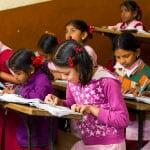Achievements

Strategy
Educating parents and elders on the importance of education. Teachers are chosen from the community and trained.

Impact
70,000+ children are being educated in 702 schools across India.

Gender ratio
48 : 52 The gender ratio in these schools is significantly higher than the national average.
Challenges
40 percent of the Indian population is under the age of 18. On April 1, 2010, India joined the league of 135 countries that have made education a fundamental right of every child. Implementing the Right to Education and providing education to nearly 500 million people in India is a daunting task. The Art of Living shares this challenge with the government and other agencies in bringing education to the most deserving children and youth in the country. It is estimated that nearly 96% of children start primary education in India. Of those who start, only 72% finish class V, only 57% finish class VIII and barely 37% end up finishing class X.
Some of our challenges include the following:
- Parents do not enroll their children in schools because of various socio-economic factors
- Children drop out after attending school for a while because of domestic pressures
- Student performance decreases with time as they encounter personal, social and economic problems
- Teachers may quit for better opportunities
- Lack of qualified teachers for senior classes Some of our We have found innovative solutions to overcome these challenges. Our risk mitigation strategy involves taking a holistic approach that involves the children, their parents, the community and the teachers.

Education rate in 2016
Roughly two-third of India is undereducated
People with less then 5 years of schooling

Dropping out of school
Only 37% end up finishing class X
96% of children start primary education
Strategy
We have a well-defined strategy for our education projects that has been developed and refined with time. This strategy is built on three pillars:
Engaging with the community: Even before the children are taught, their parents and elders have to be sensitized to the importance of education. The Art of Living proactively reaches out to community influencers to ensure that the children stay in school. School teachers are chosen from the community and are trained appropriately to ensure that the bond with the community is strong. This helps to keep the dropout rate low.
Providing free education: The children targeted for these schools come from a background of abject poverty and most of them are first generation learners. The Art of Living aims to provide free and value-based education to children from vulnerable sections while addressing the social, economic and cultural barriers that keep children away from school.
Value-based education: A major focus of our education strategy is to combine formal education with life skills that include building the child’s confidence, leadership, and interpersonal skills and developing spiritual tools through meditation techniques and a foundation of human values. The Art of Living schools nurture a child holistically. Family values are strengthened, and progressive attitudes strengthen social and cultural barriers.
Engaging with the community
choosing and training the teachers

Providing free education
most of the children are first generation learners

Value-based approach
developing confidence, leadership, interpersonal skills and spiritual tools
Till date, The Art of Living has provided free education to more than 70,000 kids. Most of them are first-generation learners.

Impact
As the result of our sustained efforts in this sector, The Art of Living today operates 702 free schools catering to almost 70,000+ children in tribal, rural areas and urban slums across 22 states in India. Highlights of these schools include:
- Many of these schools are in areas where there are no government schools
- Most of the children are first generation learners
- These schools successfully deliver a holistic curriculum that is a balance of modern education and ancient wisdom
- The gender ratio in these schools is 48 girls: 52 boys which is significantly higher than the national average
- We have trained about 1500 teachers so far
70,000+ students
are being provided free education
702 free
schools
operated across 22 states in India
48 girls: 52 boys ratio
higher than the national average
1500
teachers
trained so far
Inspiration from the community

A value-based education to my child
“I am a mason. I can’t pay the fees for my daughter’s school. Sri Sri Gnan Mandir helped me to give free and value-based education to my child. Due to the stress-free, loving, activity based and value based education, she is very happy in the school.”
Ajit Jadhav, Sri Sri Gnan Mandir Shignapur, Tal- Maan, Dist – Satara

First driver of Bengaluru’s metroline
The school’s (free school in Bengaluru) faculty is really good. My village people are so proud of me that they are now willing to listen (and send their children to school).
Priyanka N, ex-student of The Art of Living free school



















